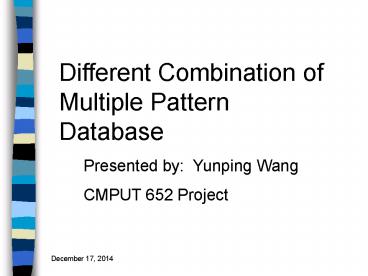Different Combination of Multiple Pattern Database PowerPoint PPT Presentation
Title: Different Combination of Multiple Pattern Database
1
Different Combination of Multiple Pattern Database
Presented by Yunping Wang CMPUT 652 Project
2
Outline
- Problem Definition
- Background
- Approach and Experiment Setting
- Preliminary Results
- Future Plan
- Reference
3
Problem Definition
- Motivation
- How best to use a fixed amount of memory for
storing pattern database? - Which performance is better?
- Using n pattern database of total size is m
- OR
- Using one pattern database of size m
4
Background
- IDA
- Richard Korf introduced Iterative Deepening A
(IDA) in 1985. - The idea is to trade space for time use less
space (a lot less space!) but have the program
run a bit slower.
5
Background
- IDA
- for a Node N, define
- g(N)the distance from the start state to N.
- h(N)an at most estimate of the distance from N
to the goal state - f(N)g(N)h(N)
6
Background
- Pattern Database
- PDB a heuristic stored as lookup table
- Created by abstracting the state space
- Guaranteed to be a lower bound
- Information stored in PDB
- abstracted states
- h value( the states distance to goal)
7
Approach
- How to get H value from multiple pattern
database? - It is admissible if every h is admissible.
8
Experiment Setting
- Total memory 10,080
- PDB selecting from
9
Experiment Setting
- PDB selection
- Do not select duplicate PDB
- Test PDB should be complementing
10
Experiment Setting
- Puzzle Type
- 8-Puzzle from class
- Testing states
- 200 start states (randomly selected) for each
combination
11
Experiment Setting
- Avoiding Unnecessary Lookup
- IDA depth bound7
- g(n) 3
- Stop doing PDB lookups as soon as hgt4 is
found. - Might result in extra IDA iterations
- h1(n) 5 next bound is 8
- h2(n) 7 next bound is 10
12
Preliminary Results --nodes generated
- One big PDB generating the biggest nodes
- Multiple smaller PDBs helps reduce the nodes
generated
13
Preliminary Results --CPU time
- No clear trend with different PDB combinations.
- CPU time is determined by the PDB combinations
and the swap cost between PDBs.
14
Preliminary Results -- nodes
generated in different group
15
Future Plan
- The optimal strategy to partition the PDB.
- Combination
- --- try different combination
- Size
- --- set the total memory in other size number
16
Reference
- J. Culberson and J. Schaeffer. Searching with
Pattern Databases, CSCSI 96 (Canadian AI
Conference), Advances in Artificial Intelligence,
Springer-Verlag, pp.402416, 1996. - R. Korf. Finding Optimal Solutions to Rubiks
Cube Using Pattern Databases, Proceedings of the
Fourteenth National Conference on Artificial
Intelligence (AAAI-97), pp. 700705, 1997. - R. Holte, Newton. Multiple Pattern Database,
Unpublished manuscript, 2001.
17
Thank for Your Attention! Question?

